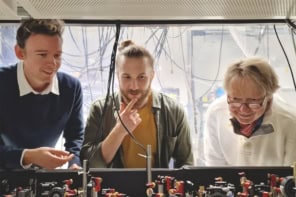Directing chemical reactions by exploiting the quantum nature of electrons has been demonstrated for the first time by physicists at the Tata Institute of Fundamental Research, India, and the Open University in the UK. The technique could prove a cheaper alternative to lasers, which until now have been the main way researchers have sought to achieve coherent control of chemical reactions.
Tata’s E Krishnakumar and collaborators exposed molecular hydrogen and deuterium to a low-energy electron beam, and used a velocity map imaging (VMI) apparatus developed by Nigel Mason and colleagues at the Open University to observe the angular distribution of the reaction products (see video). Electrons interacting with hydrogen or deuterium molecules formed temporary negative ions in a process called resonant attachment. The molecular ions then dissociated to form neutral atoms and stable hydrogen or deuterium ions.
Unexpected asymmetry
Homonuclear diatomic molecules like hydrogen are inversion-symmetric, so such dissociative attachment involving just one electron should result in a symmetric distribution of ion products. Under the laser-induced scheme, the inversion symmetry is only broken when two coherent photons deliver odd and even angular momenta simultaneously. Yet the velocity slice images obtained by the team using VMI showed a distinct asymmetry along the inter-nuclear axis.
According to the researchers, a single electron can achieve the same symmetry breaking when it causes a superposition of two negative ion resonances with opposite parity. As the resulting quantum paths interfere, the relative phase between them determines the degree of asymmetry in the fragmentation pattern produced.
Understanding the dynamics of electron-induced dissociation will allow further insight into natural processes like radiation damage to DNA, and promises improved control over chemical reactions and nanofabrication techniques.
The research is reported in Nature Physics.



